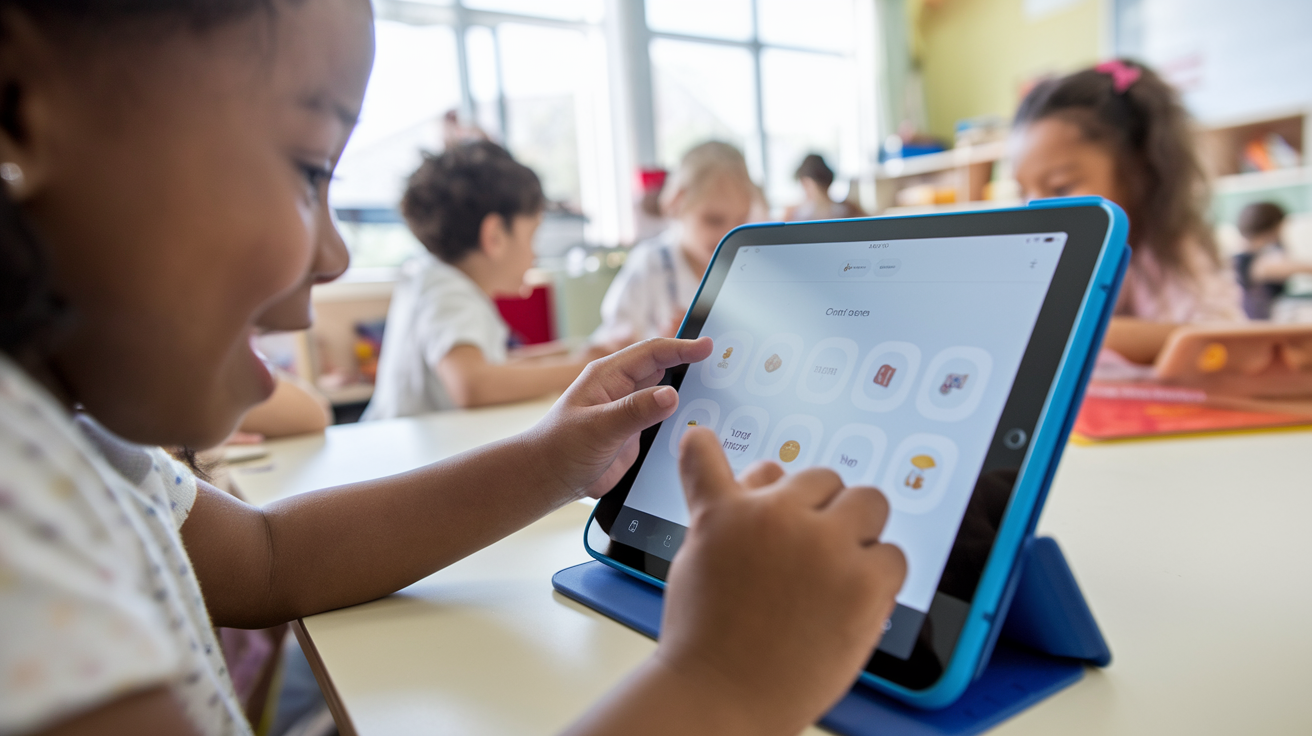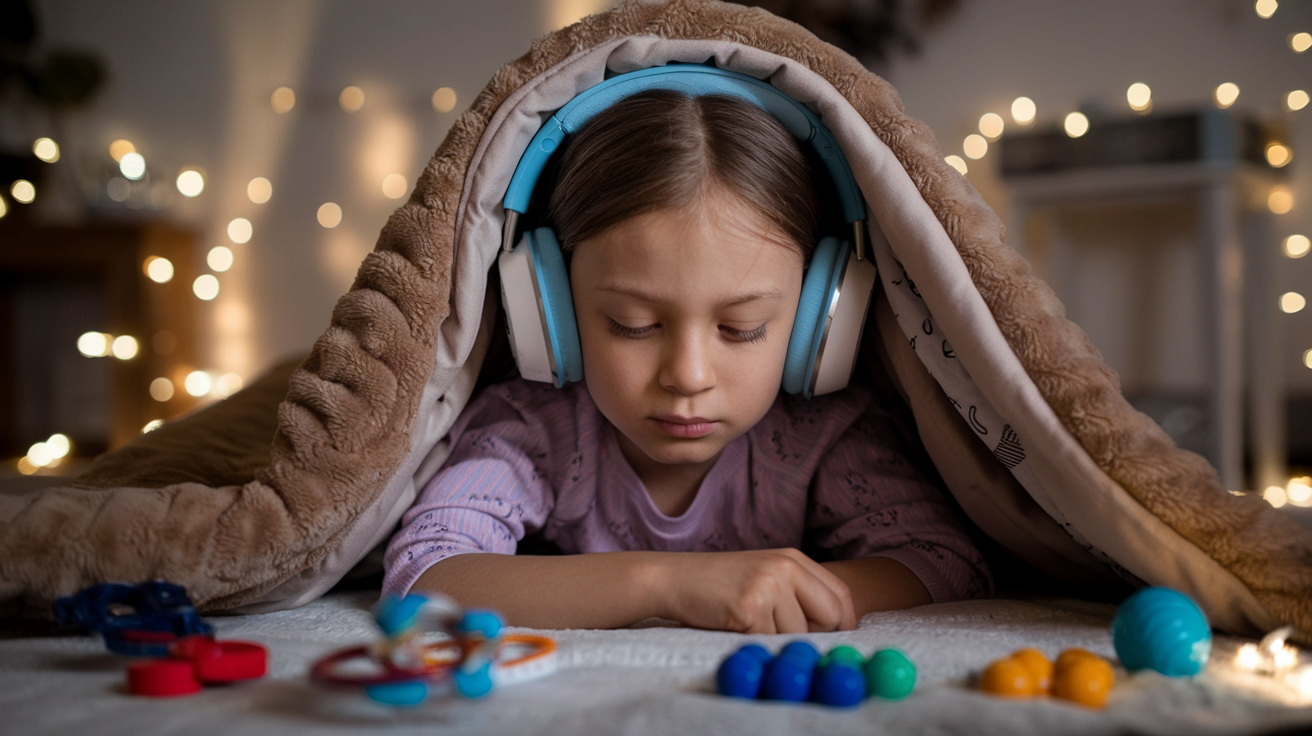Watching your child struggle with communication and making friends can be challenging. However, advancements in technology aid for autism offer heartwarming solutions. I began exploring assistive tech after noticing my son’s unique way of understanding the world. These tools, from picture boards to specialized autism apps, have transformed our lives.
Assistive technology acts as a bridge, helping children with autism communicate, interact, and gain independence. With solutions ranging from low-tech gadgets to high-tech devices, it’s easier than ever to tailor the right tools to each child’s needs.

Key Takeaways
- Assistive technology supports communication, learning, and daily life for autistic children.
- Solutions range from low-tech tools like picture boards to high-tech innovations like social robots.
- Tablets and apps play a crucial role in enhancing communication and social interaction.
- Devices help children overcome verbal and sensory challenges while fostering independence.
Understanding Assistive Technology for Autism
Assistive technology (AT) refers to tools designed to support children with autism by improving communication, learning, and sensory regulation. These tools can make a significant difference in daily life by helping children better understand and interact with the world around them. AT is typically categorized into three levels based on complexity: low-tech, mid-tech, and high-tech solutions. Below is a detailed explanation of each category, along with practical examples from daily life to illustrate their benefits.
1. Low-Tech Solutions
Low-tech solutions are simple, non-digital tools that are easy to use and cost-effective. These tools rely on basic principles of visual, tactile, or sensory support to address specific needs.
Picture Boards:
Picture boards, such as those used in the Picture Exchange Communication System (PECS), allow children to express their needs or emotions by selecting visual representations.
Example: A child at a restaurant can point to pictures of food items on a board to let the server know what they want to eat.Weighted Vests and Blankets:
These tools provide calming pressure that can help regulate sensory input and reduce anxiety.
Example: A weighted blanket can be used during bedtime to help a child feel secure and relaxed, promoting better sleep.Visual Timers:
Visual timers use a color-coded or graphical display to show how much time is left for an activity.
Example: During playtime, a visual timer helps a child know when it’s time to transition to a new activity, reducing resistance or tantrums.
2. Mid-Tech Devices
Mid-tech solutions incorporate digital components but are not as advanced or customizable as high-tech options. These tools are designed to enhance communication and learning through interactive technology.
Adaptive Audio Devices:
Devices like noise-canceling headphones or personal sound amplifiers help children focus by reducing background noise or enhancing key sounds.
Example: A child attending a noisy family gathering can wear noise-canceling headphones to stay calm and engaged in quieter conversations.Tablets and Apps:
Tablets equipped with specialized apps are versatile tools for interactive communication, education, and entertainment.
Example: A child can use a drawing app on a tablet to express their creativity or practice handwriting skills through tracing activities.

3. High-Tech Innovations
High-tech solutions involve advanced, often customizable devices that leverage sophisticated technology to address complex needs. These tools are particularly useful for non-verbal communication and social skill development.
Speech-Generating Devices:
Devices like Tobii Dynavox or apps like Proloquo2Go enable non-verbal children to communicate by turning text or symbols into speech.
Example: During a family outing, a child can use a speech-generating device to say, “I want to go to the park,” fostering participation and independence.Interactive Robots:
Robots like Milo or Jibo are designed to teach social and emotional skills through interactive role-playing and storytelling.
Example: A robot can simulate a conversation at the dinner table, teaching a child how to make eye contact and take turns speaking.
Additional Tools for Learning and Engagement
Many children with autism face learning difficulties that can make traditional classroom settings challenging. High-tech and mid-tech solutions can provide alternative ways to grasp complex concepts or practice critical skills.
Audiobooks and Digital Readers:
These tools offer auditory learning experiences for children who find reading difficult.
Example: A child struggling with reading comprehension can listen to an audiobook version of a story while following along with the text on screen.LiveScribe Pens:
These smartpens record audio while writing, helping children revisit lessons or explanations at their own pace.
Example: A student can use the pen during a science class to capture the teacher’s lecture and replay it later for better understanding.Visual Learning Apps:
Apps like BrainPOP or Endless Reader cater to visual learners by presenting concepts through animations and interactive activities.
Example: A child learning about animals can watch an animated video on habitats and then complete a puzzle to reinforce the lesson.
Practical Benefits in Daily Life
Improved Communication:
With the help of speech-generating devices and picture boards, children can express their thoughts and needs more clearly, reducing frustration and fostering better relationships.Enhanced Learning:
Tools like audiobooks and visual apps allow children to explore subjects at their own pace and in formats that suit their strengths.Reduced Sensory Overload:
Noise-canceling headphones and weighted items help children manage overwhelming sensory experiences, making environments like grocery stores or family gatherings more tolerable.Development of Social Skills:
Robots and interactive apps encourage children to practice real-life social scenarios in a safe, engaging way, boosting their confidence over time.
How Does Technology Aid Autism Communication?
Good communication is essential for building relationships and independence. Tools such as augmentative and alternative communication (AAC) devices and speech-generating apps are vital in aiding autistic children.
Augmentative and Alternative Communication (AAC) Devices
AAC devices support non-verbal communication by converting text or pictures into spoken words. Examples include:
- Picture Exchange Communication Systems (PECS): Allow children to share needs visually.
- Tablet-based AAC apps: Offer customizable ways to communicate.
Popular Speech-Generating Apps
Speech apps empower children with autism by giving them a voice. Apps like Proloquo2Go and Speech Blubs enhance confidence and interaction in social settings.
Educational Apps and Tools for Autism Support
Educational technology provides autistic children with engaging ways to learn and grow.
Speech Therapy Apps
Speech therapy apps like Articulation Station combine games with practice exercises, helping children improve speech and language skills.
Interactive Learning Apps
Interactive apps enhance critical thinking and problem-solving. Examples include:
- ABC Mouse: Offers lessons in literacy, math, and more.
- RoboKind: Engages children in role-playing scenarios to teach social skills.
Tailoring Educational Tools
As children’s needs evolve, regularly updating apps and tools ensures continued support for their learning and development.
Gadgets for Managing Sensory Challenges
Many autistic children face sensory processing difficulties. Specialized gadgets can help regulate sensory input and create a calmer environment.
Sensory-Friendly Tools
- Weighted blankets and vests: Provide calming deep pressure.
- Noise-canceling headphones: Reduce auditory overload.
- Fidget spinners and putty: Improve focus during tasks.
Advanced Sensory Gadgets
Wearable sensory monitors track emotional states and alert caregivers when children feel distressed, ensuring timely support.
Choosing the Right Assistive Technology
Selecting the right technology aid for autism involves understanding a child’s unique needs and consulting professionals for guidance. Tools should:
- Foster communication and independence.
- Address sensory or learning challenges.
- Adapt as the child grows.
Conclusion: Empowering Children Through Technology
Assistive technology offers life-changing benefits for children with autism, enabling them to communicate, learn, and thrive. Whether through low-tech picture boards, high-tech social robots, or educational apps, these tools provide vital support for their development.
By carefully selecting the right solutions, parents can help their children overcome challenges, boost independence, and engage with the world more effectively. The right technology aid for autism ensures that every child has the chance to shine and make a meaningful impact.

FAQs: Technology Aid for Autism
What Types of Assistive Technology Are Available?
Assistive technology includes low-tech tools like visual schedules and high-tech devices such as social robots. These solutions cater to communication, sensory needs, and learning.
How Do Communication Apps Help Autistic Children?
Communication apps give children a way to express themselves through visuals, text, or speech, improving interaction and confidence.
Which Educational Tools Are Most Effective?
Apps like Articulation Station and Robots4Autism effectively enhance language skills and social understanding. Interactive apps make learning fun and engaging.
What Gadgets Help Manage Sensory Challenges?
Weighted blankets, noise-canceling headphones, and sensory monitors are among the most effective tools for regulating sensory input and reducing stress.
How Can AAC Devices Improve Social Interactions?
AAC devices provide non-verbal children with a way to communicate their thoughts and needs, fostering independence and social connection.
